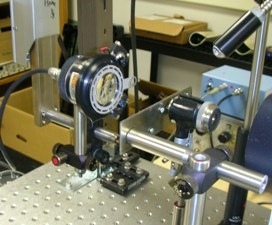Dan Mellema
Non-contact modal excitation of coupled microcantilevers through the use of ultrasound
Physics, Dr. Huber

About My Research:
This summer Brad Abell and I have been researching Non-Contact Modal Excitation of coupled microcantilevers through the use of ultrasound. Although this sounds really complicated, the ideas behind the research are simple. Microcantilevers are very small metal strips; the ones that were used were about one fifth of the width of a hair. By aiming Ultrasonic transducers at the cantilever we can shake them without physically touching them. These transducers can be thought of as very high frequency speakers – high enough they can’t be heard by humans. The actual shaking of the cantilever is much the same as standing in front of a subwoofer and feeling the vibrations caused by the music. A laser is used to measure how much the cantilever is moving, which is often a distance less than 270 times the diameter of a hydrogen atom. A program was written to take the movement information from the laser and create an animated image of the cantilever’s movement. By looking at the image we can figure out important information on how the cantilever is moving.
In the future this research could be used in chemical detectors because if a chemical were to bind to the cantilever, the frequency, or how often the cantilever shakes, is slightly changed. It could also be used in designing hard drive heads to prevent them from shaking as much when the computer is running.
In the student's own words :
"Last year I spent over a month working on boundary condition problems of partial differential equations (PDE) in PHY-230 Mathematical Methods. I could solve the equations but I did not fully understand the idea that the actual movement of the object was a composition of all the solutions.
Working with the microcantilevers this summer has really cleared up this issue. From day one, I was using FFT spectra to determine the Eigen frequencies of the cantilevers. Later two transducers were used to control the amplitude of various Eigen states. This research has allowed me to connect a purely mathematical concept that I learned in class and has coupled it with a physical system that exists in the real world."
Professional Abstract:
This summer I have been researching Non-Contact Modal Excitation of coupled microcantilevers through the use of ultrasound. The microcantilevers used were approximately 500μm long and 100μm wide. When excited, cantilevers have various Eigen frequencies that correspond to different vibrational states of the systems. Coupled cantilevers have the addition of a symmetric Eigen state, where the two cantilevers move in phase relative to each other, and an asymmetric Eigen state where the cantilevers move out of phase.
Ultrasonic excitation is advantageous because it allows for a reduction of background noise caused by mechanical excitation. It allows for selectively exciting either symmetric or asymmetric modes which can not be done through mechanical excitation. Ultrasonic transducers were used to excite cantilevers while the response of the cantilever was measured using a laser vibrometer. By using known Eigen frequencies and Comsol Multiphysics modeling software, additional Eigen frequencies were located and subsequently scanned. Each additional Eigen frequency allows for refinement of the Comsol model. Scans of each Eigen state were loaded into a Matlab Graphical User Interface that we developed this year. This interface created an animated image of the movement of the microcantilevers at different Eigen states. By studying these microcantilevers using ultrasonic excitation, computer modeling programs, and software a mathematical model can be created that extends beyond cantilevers to any micro-object.
Links:
- Learn more about the Department of Physics
- Go to the student's Faculty Research Advisor